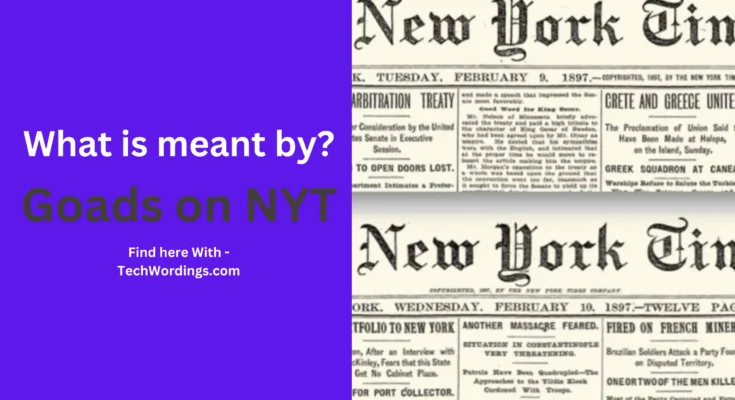In the dynamic landscape of digital journalism, the New York Times (NYT) has continually adapted its strategies to engage readers and stimulate discussions on a myriad of topics. One intriguing facet of this approach is the utilization of “Goads on NYT.” While the term may sound enigmatic to some, it plays a pivotal role in shaping online conversations and sparking debates among the NYT’s diverse audience.
In this article, we embark on a journey to unravel the mystery behind “Goads on NYT” — a phenomenon that goes beyond mere headlines and delves into the realm of provocative content designed to elicit strong reactions from readers. By understanding the nature, purpose, and impact of goads, we gain insights into the evolving landscape of digital journalism and the challenges it presents to both media outlets and their audiences. Let’s explore the intriguing world of goads and their significance in shaping the discourse within one of the most prominent news sources of our time.
Goads on NYT: What Are Goads?
Goads on the New York Times (NYT) are a unique form of content strategically crafted to provoke strong reactions and foster engagement among readers. These thought-provoking pieces can take various forms, ranging from short and bold statements to incisive questions. The intent is clear: to stimulate discussion and encourage readers to actively participate in the ongoing conversation.
Goads catalyze discourse, prompting individuals to contemplate and share their perspectives on issues that resonate with the zeitgeist. These pieces are carefully curated to be attention-grabbing, aiming to draw readers into a dialogue that extends beyond the traditional confines of news reporting.
Purpose and Intent Behind Goads on NYT:
The primary purpose of deploying goads is to transcend the one-way street of information dissemination. Unlike conventional news reporting, goads aim to break down the barriers between the publication and its audience, transforming news consumption into a dynamic and participatory experience.
Goads are designed to be more than just headlines; they are catalysts for conversation, intended to elicit a spectrum of reactions. By posing challenging questions or presenting provocative statements, the NYT seeks to foster a diverse range of opinions and perspectives among its readership.
Examples of Goads from Different NYT Sections:
To grasp the essence of goads, let’s delve into some examples from various sections of the New York Times:
- “Is cancel culture killing free speech?”
- “Is it time to break up Big Tech?”
- “Is America still the greatest country in the world?”
These examples showcase the diversity of topics that can be addressed through goads, spanning from cultural debates to questions about the fundamental values of society. Each statement is deliberately crafted to provoke thought and ignite discussions that transcend the boundaries of traditional news reporting.
Goads on NYT: Controversies and Criticisms
Critics argue against the use of goads, claiming that they are designed to generate clicks rather than inform readers. Some key points of contention include:
- Prioritizing Engagement over Information: Critics assert that the primary goal of goads is to boost online engagement and increase click-through rates, potentially overshadowing the responsibility of delivering informative and balanced content. This raises concerns about the blurred line between journalistic integrity and the pursuit of digital metrics.
- Potential for Sensationalism: Goads, by their provocative nature, may run the risk of sensationalizing issues for the sake of generating reactions. Critics argue that this approach could compromise the nuanced understanding of complex topics, leading to oversimplification and polarization among readers.
- Fueling Unproductive Discourse: Some opponents contend that goads contribute to online discussions that are more emotionally charged than intellectually substantive. The quest for attention-grabbing content, they argue, might lead to a focus on sensationalism rather than fostering constructive dialogues.
Impact on Readers and Online Discourse:
The controversies surrounding goads extend to their potential impact on readers and the broader online discourse:
- Emotional Manipulation: Goads, with their provocative language and content, have the potential to manipulate readers’ emotions, leading to strong reactions that may not be rooted in careful consideration. Critics worry that this emotional manipulation could sway public opinion without a solid foundation of well-rounded information.
- Polarization and Echo Chambers: Goads may contribute to the formation of online echo chambers, where readers are exposed only to viewpoints that align with their existing beliefs. This can lead to a polarized digital landscape, hindering the exchange of diverse perspectives and hindering the pursuit of a more comprehensive understanding of complex issues.
In the subsequent section, we will explore the New York Times’ perspective on the use of goads, providing insights into their rationale and the role they envision for goads in fostering meaningful conversations.
Goads on NYT: NYT’s Perspective on it
The New York Times (NYT) stands by its decision to incorporate goads into its digital strategy, emphasizing its role in fostering dynamic and impactful conversations. From the perspective of the NYT, goads are not mere clickbait but strategic tools designed to elicit thoughtful responses from readers and encourage them to actively participate in discussions on pressing issues.
- Fostering Dialogue: According to the NYT, goads play a crucial role in fostering dialogue and encouraging readers to critically engage with the news. By presenting provocative statements and questions, the NYT aims to stimulate diverse perspectives and cultivate an environment where readers feel compelled to share their insights.
- Sparking Meaningful Debates: Goads, as envisioned by the NYT, serve as catalysts for meaningful debates. By posing controversial questions or presenting bold statements, the intention is to prompt readers to reflect on their own beliefs and engage with others who may hold different viewpoints. In this way, goads contribute to a vibrant exchange of ideas.
- Adapting to Changing Media Dynamics: The NYT contends that the use of goads reflects an adaptation to the changing dynamics of digital media consumption. In an era where attention spans are limited, goads serve as a strategy to capture readers’ interest and encourage them to delve deeper into the nuanced discussions presented in NYT articles.
- Balancing Engagement and Responsible Journalism: Crucially, the NYT emphasizes the importance of striking a balance between engagement and responsible journalism. While goads aim to spark conversation, the NYT asserts its commitment to upholding journalistic standards and providing readers with accurate, well-researched information.
In the next section, we will explore specific examples of goads published by the NYT, shedding light on the content that has generated discussions and reactions from readers. These examples will provide a tangible understanding of how goads manifest in the NYT’s digital landscape.
Examples of Goads on NYT
To illustrate the application and impact of goads on the New York Times (NYT), let’s delve into specific examples that have captured the attention of readers and fueled discussions on various platforms.
1- “Is cancel culture killing free speech?”
This goad probes the boundaries between societal accountability and the preservation of free expression. By posing a question laden with contemporary relevance, the NYT invites readers to explore the complexities surrounding cancel culture and its implications on the broader discourse of free speech.
2- “Is it time to break up Big Tech?”
Addressing the growing influence of technology giants, this goad challenges readers to contemplate the potential consequences of concentrated power in the tech industry. The provocative nature of the question encourages readers to assess the merits and drawbacks of such a proposition, prompting diverse perspectives on the role of Big Tech in society.
3- “Is America still the greatest country in the world?”
This goad taps into national pride and identity, inviting readers to reflect on their perception of America’s standing on the global stage. By framing the question in a manner that challenges conventional notions, the NYT prompts readers to critically assess the factors that contribute to a nation’s greatness.
These examples showcase the diversity of topics explored through goads, ranging from societal trends like cancel culture to pressing issues concerning technology and national identity. Each goad serves as a conversation starter, encouraging readers to share their viewpoints and engage in meaningful dialogues with one another.
Goads on NYT: Reader Awareness
Defining the Subjectivity of Goads:
While the New York Times (NYT) strategically deploys goads to spark discussions, readers need to recognize the subjective nature of these provocative pieces. The term “goad” itself may be interpreted differently by individuals, contributing to varying perspectives on what qualifies as a goad.
- Subjectivity in Definition: Readers may differ in their definitions of what constitutes a goad. Some may consider any content designed to elicit strong reactions as a goad, while others may reserve the term for intentionally provocative material. This subjectivity underscores the dynamic nature of media interpretation.
- Interpreting Provocation: The degree of provocation in goads is subjective, and what one reader finds stimulating, another might perceive as sensationalized. Recognizing this subjectivity encourages readers to approach goads with a discerning eye, evaluating the intent behind the provocative elements and considering various perspectives.
- Diverse Reader Reactions: Goads aims to generate diverse reader reactions, fostering a spectrum of opinions on the presented topics. Reader awareness involves acknowledging the potential for differing interpretations and engaging in constructive discussions rather than succumbing to polarized viewpoints.
Encouraging Critical Consumption:
In an era of information abundance, cultivating reader awareness is crucial. As readers encounter goads on the NYT and other platforms, it becomes imperative to approach such content critically:
- Questioning Intent: Readers should question the intent behind goads, considering whether the provocative elements are designed to stimulate thoughtful discussions or merely to attract attention. Understanding the motivation behind the content enhances reader discernment.
- Recognizing Emotional Manipulation: Awareness of emotional manipulation is essential. Goads, by nature, may evoke strong emotions, and readers should be attuned to the potential impact of such emotional reactions on their interpretation of the presented information.
- Seeking Context: Gaining a broader understanding of the context surrounding goads is key. Readers benefit from exploring the complete articles associated with goads, as well as considering alternative viewpoints to form well-informed opinions.
Reader awareness of goads involves an acknowledgment of subjectivity, a commitment to critical consumption, and an openness to diverse interpretations. As we navigate the evolving landscape of digital journalism, recognizing the role of goads empowers readers to engage thoughtfully with the news and contribute meaningfully to the ongoing conversations shaping our society.
Conclusion
In our exploration of the intriguing realm of ‘Goads on NYT,’ we’ve peeled back the layers of provocative content strategically employed by the New York Times to shape online discussions. As we conclude this journey, several key insights emerge, highlighting the significance and impact of goads in the evolving landscape of digital journalism.
Goads, as revealed through examples and analysis, serve as dynamic catalysts for discourse. Whether probing the boundaries of free speech, challenging the influence of Big Tech, or questioning national identity, these thought-provoking pieces spark conversations that extend far beyond the initial provocations.
Controversies surrounding goads underscore the fine balance between engagement and responsible journalism. Critics raise valid concerns about potential sensationalism, emotional manipulation, and the risk of fostering unproductive discourse. These criticisms prompt essential reflections on the ethical considerations in the pursuit of audience engagement.
The New York Times, in its defense of using goads, emphasizes its role in fostering dialogue, sparking meaningful debates, and adapting to the changing dynamics of digital media. The NYT’s commitment to balancing engagement with responsible journalism positions goads as strategic tools for navigating the challenges of the contemporary media landscape.
Crucially, understanding ‘Goads on NYT’ requires acknowledging the subjectivity inherent in defining and interpreting these provocative pieces. Reader awareness plays a pivotal role, encouraging a discerning approach, questioning intent, recognizing emotional manipulation, and seeking context to form well-informed opinions.
In the intricate tapestry of digital journalism, goads emerge as threads that weave through the fabric of online discourse. They challenge, provoke, and stimulate, urging readers to not merely consume but actively engage with the news. As we continue navigating this ever-evolving landscape, ‘Cracking the Code: Understanding ‘Goads on NYT” invites readers to be vigilant, critical, and active participants in the ongoing conversations that shape our understanding of the world. Ultimately, the decoding of goads unfolds as a dynamic journey, with each reader contributing to the narrative, enriching the discourse, and embracing the responsibility that comes with being an informed digital citizen.



